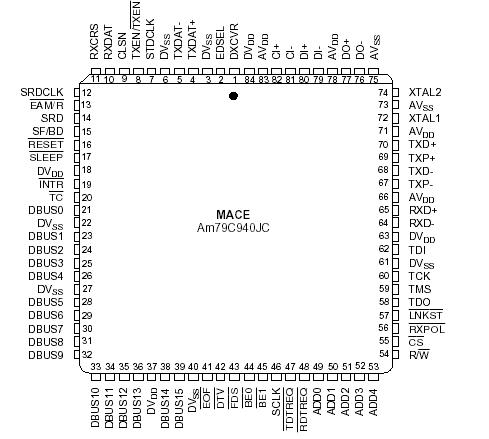Pinout
SpecificationsStorage Temperature . . . . . . . . . . . . . . .65°C to +150°C
Ambient Temperature
Under Bias . . . . . . . . . . . . . . . . . . . .. . . . . . . 0°C to +70°C
Supply Voltage to AVSS
or DVss (AVDD, DVDD) . . . . . . . . . . . . . . . . .0.3 V to +6.0 V DescriptionThe Media Access Controller for Ethernet (MACE) chip is a CMOS VLSI device designed to provide flexibility in customized LAN design. The MACE Am79C940 device is specifically designed to address applications where multiple I/O peripherals are present, and a centralized or system specific DMA is required. The high speed, 16-bit synchronous system interface is optimized for an external DMA or I/O processor system, and is similar to many existing peripheral devices, such as SCSI and serial link controllers.
The MACE Am79C940 device is a slave register based peripheral. All transfers to and from the system are performed using simple memory or I/O read and write commands. In conjunction with a user defined DMA engine, the MACE chip provides an IEEE 802.3 interface tailored to aspecific application. Its superior modular architecture and versatile system interface allow the MACE device to be configured as a stand-alone device or as a connectivity cell incorporated into a larger, integrated system.
The MACE Am79C940 device provides a complete Ethernet node solution with an integrated 10BASE-T transceiver, and supports up to 25-MHz system clocks. The MACE device embodies the Media Access Control (MAC) and Physical Signaling (PLS) sub-layers of the IEEE 802.3 standard, and provides an IEEE defined Attachment Unit Interface (AUI) for coupling to an external Medium Attachment Unit (MAU). The MACE device is compliant with 10BASE2, 10BASE5, 10BASE-T, and 10BASE-F transceivers.
Additional features also enhance over-all system design. The individual transmit and receive FIFOs optimize system overhead, providing substantial latency during packet transmission and reception, and minimizing intervention during normal network error recovery. The integrated Manchester encoder/decoder eliminates the need for an external Serial Interface Adapter (SIA) in the node system. If support for an external encoding/decoding scheme is desired, the General Purpose Serial Interface (GPSI) allows direct access to/from the MAC. In addition, the Digital Attachment Interface (DAI), which is a simplified electrical attachment specification, allows implementation of MAUs that do not require DC isolation between the MAU and DTE. The DAI port can also be used to indicate transmit, receive, or collision status by connecting LEDs to the port. The MACE device also provides an External Address Detection Interface (EADI) to allow external hardware address filtering in internetworking applications.
The Am79C940 MACE chip is offered in a Plastic Leadless Chip Carrier (84-pin PLCC), a Plastic Quad Flat Package (100-pin PQFP), and a Thin Quad Flat Package (TQFP 80-pin). There are several small functional and physical differences between the 80-pin TQFP and the 84-pin PLCC and 100-pin PQFP configurations.
Because of the smaller number of pins in the TQFP configuration versus the PLCC configuration, four pins are not bonded out. Though the die is identical in all three package configurations, the removal of these four pins does cause some functionality differences between the TQFP and the PLCC and PQFP configurations. Depending on the application, the removal of these pins will or will not have an effect.

 Am79C940 Data Sheet
Am79C940 Data Sheet







